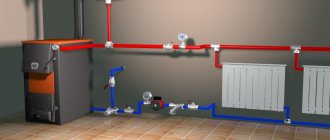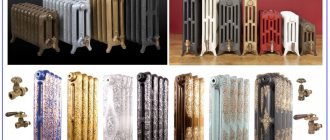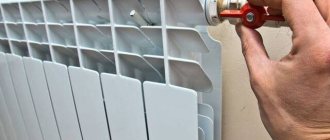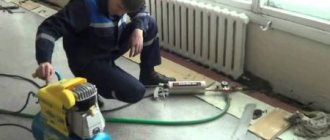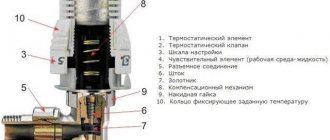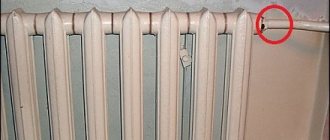Why do you need to make adjustments?
Setting the optimal temperature of the heating radiators allows you to create the most comfortable living conditions indoors. In addition, adjustment allows:
- Remove the effect of air in the batteries, allow the coolant to move freely through the pipeline of the heating system, effectively transferring its heat to the interior of the room.
- Reduce heat consumption costs by up to 25%.
- Do not keep windows constantly open if the air in the room is excessively overheated.
It is advisable to set up heating and adjust batteries before the start of the heating season. This is necessary so that later you do not experience discomfort in the apartment and do not adjust the heating temperature of the batteries in emergency mode. Before setting up and adjusting the radiators, initially in the summer you need to thermally insulate all windows. In addition, you need to take into account the specific location of the apartment:
- In the middle or corner of the house.
- Lower or upper floor.
After analyzing the situation, it is advisable to use energy-saving technologies to maximize heat conservation inside the apartment:
- Insulate walls, corners, floors.
- Carry out hydro and thermal insulation of the seams between the concrete joints of the panel house.
Without this work, it will be useless to regulate the temperature of the radiators, since the lion's share of the heat will heat the street.
Step-by-step instructions for adjusting temperature
To ensure comfortable living conditions in the room, you need to perform some basic steps.
- Initially, it is necessary to bleed the air on each battery until water flows from the tap in a trickle.
- Then you need to adjust the pressure in the batteries.
- To do this, in the first battery from the boiler you need to open the valve by two turns, on the second - by three, and then according to the same scheme, increasing the number of turns of the valve being opened on each radiator. Thus, the coolant pressure will be evenly distributed over all radiators. This will ensure its normal passage through the pipes and better heating of the batteries.
- In a forced heating system, control valves will help to pump the coolant and control rational heat consumption.
- In a flow-through system, the temperature is well regulated by thermostats built into each battery.
- In a two-pipe heating system, you can control not only the temperature of the coolant, but also its quantity in the batteries using both manual and automatic control systems.
Purpose. Characteristic
Taps ensure efficient operation of water pipes. The heating system cannot operate without these devices, and in some situations, using it without them becomes downright dangerous.
When the riser leaks, it is the shut-off valves that shut off the water, which makes it possible to make repairs without stopping the entire system
An important function will also be managing the heat dissipation of the battery.
The minimum set for the normal functioning of a conventional heating system consists of several types of shut-off and control valves. When connecting to the radiator, shut-off ball valves are mounted on the supply pipes, on the outlet and on the bypass. A mechanism is installed on the supply to adjust the coolant pressure. The radiator itself must be equipped with a Mayevsky tap. to bleed air. As you can see, the number of such products is significant and this is by no means an excessive option.
Taken together, this system allows:
- turn off the radiator without shutting off the entire circuit for repair, replacement, or maintenance;
- direct all coolant through the heater with the bypass turned off;
- control the pressure power through the radiator to reduce or increase the temperature;
- drain water, bleed air;
- protect the system from hydraulic shocks and breakdowns;
- regulate the efficiency and level of heat supply, which saves heating costs.
Requirements
The criteria for the variety of types of taps placed on heating radiators are: design, principle of operation and material
It is important to know that mechanisms of this type are divided into shut-off and control valves. What are the best taps to install? It must be taken into account that they have a rather complex structure and must meet a number of requirements in order to function in difficult conditions
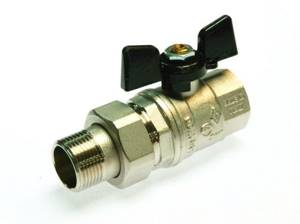
- coolant temperature up to 200°C;
- must withstand pressure of 16–40 bar;
- high corrosion resistance;
- resistance to mechanical loads.
For heating systems, such mechanisms are made more stable. Conventional taps and valves for cold water cannot be installed in heating radiators.
Each connection has its own characteristics: there are regular and corner (for the bottom connection) taps. This division allows you to maximize the distribution of pipes when installing a heating system. The design features of the valves allow you to hide the pipes behind the decor, in a screed, or to mount radiators in a small space under a window opening.
In everyday life, the general name is used - “faucets”. But from a technical point of view it is correct to distinguish:

Heating systems also use thermostats; it is not recommended to use dampers or valves in radiators - they quickly become inoperable. If shut-off valves are needed, then ball valves are the best for this. They have only two positions - closed/open. Valves with a cone are designed to control the pressure manually. There are also mechanisms for automatic adjustment - these are thermostats with valves or cones.
Why do radiators need taps?
For clarity of understanding, let's immediately clarify the special terminology. In everyday life, taps are any plumbing device that has a handle to control the flow of water. In fact, it is technically correct to call a valve a shut-off valve, and not a control valve. That is, it is intended only to block the flow of liquid, and to regulate its quantity there are other devices - gates and valves. Moreover, all these products are used for batteries.
Shut-off and control valves are placed on the supply pipelines to heating devices for the purpose of:
- turning off the battery during periods of the year when it is not too cold outside or for other reasons;
- shutting off the water for inspection and washing of the device without emptying the entire pipeline network;
- manual or automatic control of coolant flow, adjusting its quantity depending on the room temperature.
The first point of this list makes it perfectly clear why installing taps on heating radiators is interconnected with energy saving. Such a situation when the central heating system is turned on during the warm period is not uncommon (as well as it is turned off in winter). If there is a thaw or it is warm enough outside, and the heating is already on, then the room becomes stuffy. The presence of taps on the battery solves this problem with one turn of the handle. And if a heat energy meter is installed on the entire entrance or the entire house, then with this movement you simply block the flow of funds from your own budget to the account of the utilities.
Taps bring even more favorable savings in your own home, equipped with individual heating. Taps allow you to screw on or completely disconnect a certain part of the radiators. Equally important for saving money is periodic flushing of heating appliances. What this means is that a contaminated battery inside gives off significantly less heat to the heated room, which means that coolant with a lower temperature passes through the return pipe.
Clogged radiators lead to the fact that the coolant will not heat your home, but your neighbor’s, and there will be a noticeable lack of warmth in your home. If we are talking about a private home, then there are no such noticeable heat losses due to clogging. But in the premises of the home themselves, it becomes noticeably cooler. Therefore, in order to heat the room, you will have to increase the temperature in the boiler for the heating system. This leads to increased fuel consumption by the heating boiler. The process of radiator contamination is unpleasant because it takes considerable time to detect problems until an increase in the cost of heating the house becomes clearly noticeable.
The use of control valves in heating makes it possible to consume energy much more economically throughout the entire heating period by adjusting and constantly maintaining the desired air temperature in the rooms.
Taps and valves allow you to regulate energy consumption during operation of the heating system.
Thermostatic valve
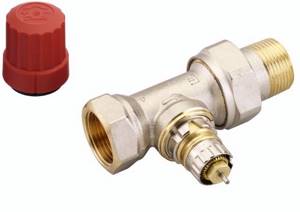
In modern realities, a thermostatic valve is a prerequisite for modern and reliable equipment in a heating system. The valve temperature is automatically adjusted. The operation of a heating system mixing valve for radiators is to limit the supply level to an individual heating radiator. The valve stem makes movements to open and close the hole. Through this hole, coolant enters the radiator. When the valve with a thermostatic head heats up, the inlet opening is closed, as a result of which the coolant flow rate decreases. The thermostatic valve constantly changes its position. And an important factor is the quality of the materials on which this product is made. The product may fail due to sticking of the rod, as well as significant corrosion and breakthrough of sealing materials. But even if the thermostatic valve fails, you can extend its service life by replacing the thermostatic element.
Heating system valves with thermal heads differ depending on the shape and type of supply to the heating system. They can be angular when connected to radiators from the floor, or they can be straight, which connect the pipes to the battery relative to the wall surface. Axial, mainly when connecting pipes from the wall to the battery. When connecting batteries sideways, a special kit is required. It uses thermostatic heads and valves. Batteries that come with a bottom connection are obviously equipped with valve-type inserts.
Valves from the Danish manufacturer Danfoss.
WATTS 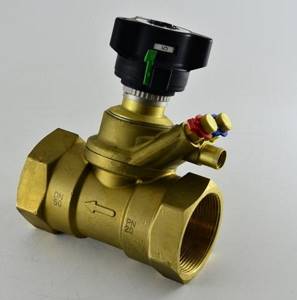
, another manufacturer is the Danish company
DANFOSS
, which supplies valves of all types, characterized by high quality workmanship.
MSV-BD LENO™
manual valves are a new generation of valves. They allow solving problems of hydraulic balancing of heating systems. In doing so, they combine the functions of a standard manual valve and a ball valve, thereby ensuring fast and complete shut-off of the flow. Most models allow you to take data at the outlet and inlet, but some models have a nipple only on one side.
Automatic valve ASV-M.
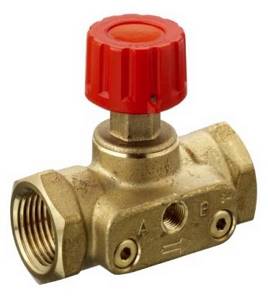
ASV-M
, the price of which suggests an optimal price-quality ratio, can be used as a shut-off valve and, if necessary, connecting an impulse tube from
ASV-P(V)
.
ASV-I
.
It allows you to limit the maximum flow rate of the transported coolant. The valve is equipped with special plugs for measuring nipples. By installing nipples, you can measure the coolant flow that flows through a specific section of the system.
Valves of the ASV series are distinguished by high quality workmanship.
They allow you to maintain a constant pressure difference between the supply and return pipelines. The ASV-P, installed on the return line, features a fixed setting of 10 kPa. While the ASV-PV
has a measurable setting of 5-25 kPa,
the ASV-PV Plus
has a measurable setting of 20-40 kPa.
However, many owners of private houses are wondering what to do when consumption changes. This can happen when radiators are supplemented with thermostatic regulators, which are responsible for the intensity of heating the room, creating an obstacle in the way of water.
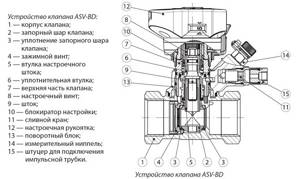
Balancing valve
The design of a valve for regulating heating differs from a conventional ball valve in that it can smoothly close the flow area in a few turns. Moreover, after balancing, the position of the valve can be fixed so that no one accidentally violates the settings. This type of control valves is installed at the outlet of the radiator, as shown in the diagram:
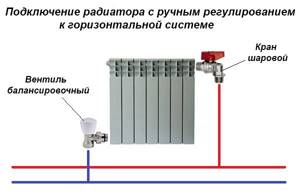
Shown here is the connection to a two-pipe horizontal system, most common in private houses and apartments with individual heating. By the way, the principle of installing fittings with a single-pipe scheme remains the same. A regular ball valve is installed on the supply line, and an adjustment valve is installed on the return line. In the case when a two-story house has a system with vertical risers, the installation diagram of the accompanying fittings looks like this:
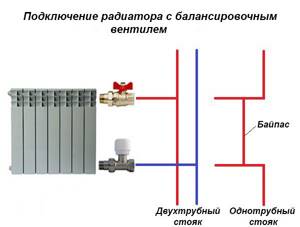
The principle of product selection is the same as in the previous section
Straight or angular design is accepted depending on the layout of equipment and pipelines; it is also important to use American designs during assembly
Pay special attention to the quality of casting and the thickness of the brass walls of the fittings. If you have networks made of polypropylene pipes, do not rush to buy PPR taps; it is better to install adapters and reliable metal products
Advice. Balancing valves are installed on all radiators, except for the very last one, located at the dead end of the branch. It is enough to install simple ball valves on the connections to it.
Crane installation
The installation diagram depends on the type of shut-off and control valves selected.
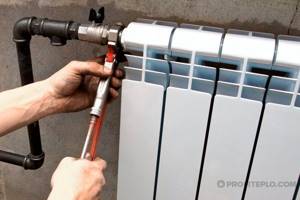
Faucet installation process
The most common installation options are:
:
- In a single-pipe central heating system, 2 ball valves are installed between the radiator and the bypass - on the inlet and outlet pipes. This makes it possible to leave it filled when draining coolant from the system during network repairs, to disconnect or dismantle the battery for painting, cleaning, or replacement.
- In an autonomous two-pipe system, a thermostatic valve is placed on the supply pipe, and a balancing valve is installed on the return pipe, which will be responsible for maintaining normal operating pressure.
- In an autonomous one-pipe system, you can install a ball valve on the supply pipe, and a control valve on the return pipe. If the valve has a coolant flow cut-off function, a second ball valve on the heating radiator is not required.
Installation of ball valves
Ball valves, which are installed on a heating radiator, have two operating positions: “open” and “closed”. Partially blocking the coolant flow using this type of fittings is prohibited. As a result of improper operation, the device may fail and begin to leak.
The device can have a straight or angular design - the choice depends on the layout of the system. If the installation of regulators is not provided between the shut-off valves and the radiator, the ball valve can be installed directly on the heating device using a squeegee - a special additional part.
Before installation, make sure that the device parameters (working pressure, maximum permissible ambient temperature) correspond to the characteristics of the heating system. The direction of flow is indicated on the valve body - installation is carried out in accordance with the mark.
The valve on the radiator is on the return line, you need
Well, as I understand it, there will be no heating in the whole house until you return the radiator or close the system. Again, as far as I understand, frequent flushing of radiators (systems) is not advisable, but I don’t care.
Frequent flushing is beneficial to the system, but only if you then fill it with prepared water. And yes, until you fix it, you won’t turn it on.
If the system is on water, the water is the same year after year, it is better than fresh because
1 it is degassed - there are few gases dissolved in it, which can create air pockets. 2 it is already neutral in relation to the system - it has dissolved what could be dissolved, where it was possible to deposit a precipitate - it has already deposited.
And if instead of water there is antifreeze, then God himself ordered to save it. It is more expensive than taps.
Of course, if installed, the taps are full bore.
It's better to put it in, of course. It’s not a fact that you will rarely use it, because... Now in a crisis, radiators can be molded from such a thing. draining the system in a couple of minutes?! Yes, you can go to the sewer, if there is one. Is it necessary to overfill the septic tank or have a capacity of 300 or more liters?
If the system is on water, the water is the same year after year, it is better than fresh because
1 it is degassed - there are few gases dissolved in it, which can create air pockets. 2 it is already neutral in relation to the system - it has dissolved what could be dissolved, where it was possible to deposit a precipitate - it has already deposited.
And if instead of water there is antifreeze, then God himself ordered to save it. It is more expensive than taps.
Of course, if installed, the taps are full bore.
I decided to install a return valve. Somewhere I came across an article on adjusting two-pipe systems if there are several radiators in the CO branch using a valve on the return line. I can't find this article right now. But as I remember, the point is that as you move away from the manifold, the valves are clamped less and less tightly. I'm right? I can find ball valves without any problems - will they fit? Or do you need a non-ball one?
Types of work with heating radiators
Currently, many apartments have modern bimetallic or aluminum heating radiators. Such units can be monolithic or sectional. The difference is that in sectional models it is possible to install and dismantle individual standard sections.
Such devices are specially designed to be as easy to disassemble as possible. Therefore, adding/removing individual sections can be done not only for the purpose of repairing and replacing damaged elements, but also to adjust the thermal balance of the room. Adding sections will increase the average temperature in the room, while removing them will decrease it.
Almost all models of old cast iron radiators, installed back in Soviet times, theoretically provide for the possibility of freely removing or adding individual modules. In practice, over many years of operation of such products, the fastening parts, under the influence of many heating/cooling cycles and as a result of reactions with the coolant, “stick” to the radiator and to each other, so it is advisable to remove sections of cast iron radiators only for the purpose of replacing them or completely dismantling them.
Heating radiators can be called the most famous equipment, since almost every person has encountered it. However, not everyone understands what is needed to install such a seemingly simple device and how its component elements work. In particular, we are talking about the radiator cap, which most likely not many people know about.
Features of installation and maintenance of regulators
Thermostat installation diagram
After choosing the optimal model of thermostat or tap for regulating the heating temperature, you should install them correctly. The location of the fittings directly depends on its function and design.
Most often, the adjustment components are mounted in the trim of a specific heating radiator. They are installed on the supply pipe or on the bypass. In order to comfortably adjust the temperature of the radiators, it is recommended to adhere to the following rules:
- The device should not be covered with decorative panels or other interior items;
- The service life of thermostats largely depends on the quality of the coolant. Therefore, a mesh filter should be installed in front of it, which will protect the valve seat from limescale;
- When installing the heating temperature control valve, you must follow the installation diagram. On the body of the device, arrows indicate the direction of movement of the coolant;
- Many thermostats and servos are connected to the electrical network. Therefore, it is necessary to provide power supply to them.
Before installing and further adjusting heating batteries in an apartment, you must read the manufacturer's instructions. It specifies the installation conditions for the operation of a specific adjusting element.
One of the important indicators of apartment heating control valves is the maximum and minimum throughput. They must match the current system parameters.
Maintenance of regulators and valves
Pressure testing is carried out only after installing the control valves
After installation, preliminary adjustment of the taps on the heating radiators should be carried out. To do this, the operating temperature and pressure in the system must be normal. Then, by changing the degree of heating of the coolant, the operation of the control valves is checked. The system is tested in several modes. Alas, it will not be possible to independently adjust the heating in an apartment building using this scheme, since consumers do not have the opportunity to change the degree of heating of the coolant.
In fact, it is possible to check the performance of a specific element only when starting up the central heating supply. Those. Correct adjustment of heating radiators in the apartment is carried out during the heating season.
During the startup of the heating system, the heating system of a private house must be fully adjusted. It should include the following steps:
- Checking the functionality of taps and thermostats;
- Compliance of their actual parameters with passport data;
- If, during the control adjustment of the degree of heating of the heating batteries, a faulty element is detected, it must be replaced.
In addition, you need to remember that the operation of the system is influenced by a number of external factors: the degree of thermal insulation of the house, the climatic features of a particular region. This should also be taken into account when adjusting the temperature of the heating radiator.
The video shows an example of organizing the adjustment of heating radiators in a house:
Rules for the selection and installation of plugs
The simplest element used when installing and assembling radiators is an aluminum plug for heating radiators. But even the simplest device requires special attention, otherwise big problems may arise during operation.
The process of installing a radiator plug cannot be called complicated, since almost all of them are made of the same type; the dimensions or type of thread may be different. Such devices also work on the same principle.
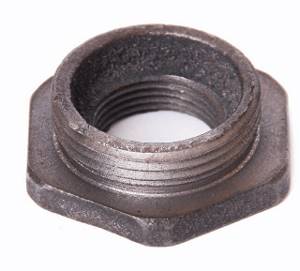
When choosing a radiator cap, it is important to consider the following points:
- The materials of the radiator and plug must be combined.
- The thread of the plug must be of a certain type. For example, for installation on the left side of the battery, it is recommended to use a left-hand thread, and on the right side, install a radiator plug with a right-hand thread.
- The hole in the radiator can be closed with a blind or through plug.
- The device must have an aesthetic appearance and match the color of the heating device.
- The diameter of the threads in a cast iron battery at the inlet and outlet is of great importance; plugs can be used as transition elements.
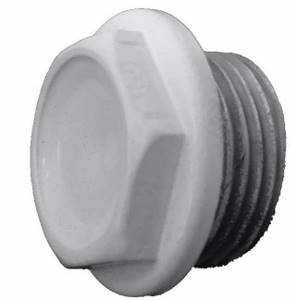
Most often, the battery is equipped with the following devices:
- Pass-through plugs for radiators in the amount of 4 pieces.
- Brackets for installing the heating device and plastic anchors for installing the fasteners themselves. For a standard size radiator, 2 brackets and anchors are required.
- Mayevsky plug and tap. Sometimes the second element is replaced with another plug.
According to the principle of operation, plugs are divided into two types. In the first case, they simply block the path of the coolant, in other words, they act as a plug. The second type is an adapter from one diameter to another. In this case, the plug has an external thread on one side and an internal thread on the other.
Installation of ball valves on batteries
A conventional ball valve is designed only to switch to 2 positions: “open” and “closed”. It cannot be used to regulate the flow of coolant through the radiator, only shut it off. The figure below shows a simple connection diagram for a heating device with this type of fittings:
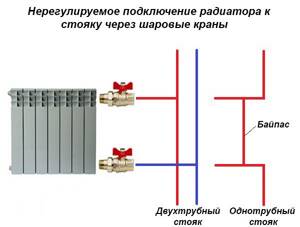
The proposed scheme is the best option for an unregulated connection of a radiator to the central heating risers in an apartment. You won’t have to balance it anyway, and installing a thermostatic valve is pointless due to the poor quality of the coolant. Instead of a ball valve at the outlet, it is also practiced to install a so-called shut-off valve; its difference is only in appearance.
Depending on the layout of appliances and heating pipes, you can choose an angle valve for a radiator with or without a decorative coating
Also, when choosing a product, it is recommended to pay attention to the operating pressure indicated on the product body or in its passport. It must correspond to the pressure in the heating network of the apartment building
Advice. For installation on the radiator, choose good taps made of thick-walled brass and a connection with an American union nut. It will allow you to quickly disconnect the connections without rotating the elements. On a single-pipe riser, do not forget to install the bypass with a slight offset away from the main pipe.
Why are there taps on radiators?
Each heating device is a separate element of the system that requires adjustment and periodic maintenance. If you control the coolant flow through the batteries depending on the heat demand, you can achieve good results in terms of energy savings. That is, radiator valves and heating taps are designed to solve the following problems:
- Complete isolation of the heating device from the system.
- Restriction of coolant flow through the battery.
- Change in coolant flow depending on external conditions.
- Bleeding air from the radiator and piping network.
There are many situations in which it is difficult to do without disconnecting the battery. For example, properly working central heating in the middle of spring, when it’s already warm outside, but it’s just hot in the apartment. Another case is the need to remove a heating device for the purpose of replacement, flushing or repair. In the absence of shut-off valves, carrying out any action with the radiator becomes problematic.

Valves are also installed on batteries in retro style
Restriction of the flowing coolant is carried out in order to balance individual heating in a private house or apartment
No matter what type of heating system you have, without balancing with valves, the first radiators will always receive more water than the last ones. Limiting the coolant flow at the beginning of the network and thereby balancing all devices with each other is the task of the control radiator fittings
Automatic control of the flow of incoming coolant is a way to save energy used to heat the house. If each tap on the heating radiator maintains the set air temperature in the room by controlling the flow of water through the radiator, then in general the system will consume only the required amount of heat, no more. And this is a considerable saving.
Well, the problem of air release when filling the system or during operation is also solved by special air valves installed on all modern radiators. Below is a list of types of shut-off and control valves, listed in the same order as the tasks they solve:
- Half-turn ball valves in straight and angle versions. Made from brass, bronze or polypropylene with a metal insert.
- Balancing valves for radiators – straight and angular.
- Regulating valves with thermal heads (thermostatic valves).
- Air drain valves – automatic and manual.
Now we should consider in detail which taps are best installed on radiators in various conditions and circumstances. Some options are clearly shown in the video:
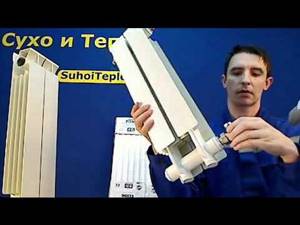
Watch this video on YouTube
—
CONDITION 1
RESULTS ROOM ¸ÐºÐ°Ð¼Ð ¸ regurgitation ÑелÑкой. â
RESULTS ºÑÐ°Ð½Ñ ÑÑÑанавливаÑÑ Ñ Ð½Ð°Ð³ÑеваÑелÑнÑÑ Ð¿ÑибоÑоР²Ñи ÑÑем оÑоплениÑ; RESULTS ¾Ð´Ñ, поÑÑпаÑÑей в нагÑеваÑелÑнÑй п ÑибоÑ. â
| RESULTS. â |
RESEARCH, RESULTS ASSESSMENT I'm sorry. RESPONSIBILITY, RESPONSIBILITY ¿Ð¾Ð»Ð¾Ð¶ÐµÐ½ близко к ÑÑоÑÐºÑ Ð¸ Ñоеди → ´Ð¸Ð°Ð¼ÐµÑÑа, ÑÑо ÑаÑе вÑего вÑÑÑÑеÑаеÑÑÑÑ Ð¿°Ñи Ð¾Ð´Ð½Ð¾Ñ ÑÑбной Ñи ASSURANCE, ASSURANCE, CONTROL ±Ð¾Ñом и ÑÑоÑком ÑеÑез обÑаÑнÑÑ Ð¿Ð¾Ð´Ð²Ð¾Ð´ÐºÑ Ð¿ÑÐ ¾ RESULTS RESULTS , , , , , , , , , , , ²ÑаÑаеÑÑÑ Ð² ÑÑоÑк по ниР¶Ð½ÐµÐ¹ ÑаÑÑи подводки. â
Ðñ ° ðory ð´²²ð¹ð¹ð½^ ñ ñµices ”ðñ½ºð (ð¿ñuthently ( " registry ¾Ð±ÑаÑной) ÑоглаÑно пÑоекÑÑ. RESULTS RESULTS ¾Ð²ÐºÐ¸ пÑи RESULTS with the ÑоÑодР°. â
| RESULTS . â |
RESULTS RESULTS Ñ Ð ¿Ð¾ диамеÑÑам в ÑÑÑÐºÐ°Ñ Ñ Ð¿Ð¾Ð´Ñазделением на RESULTS. â
| RESULTS ÑлиÑовки ной ÑегÑлиÑовки. â |
RESULTS 100 Ð ¡. 100 rubles. â
| RESPONSIBILITY. â |
RESEARCH (No. 132, No.) A Ð¾Ð¿Ð»ÐµÐ½Ð¸Ñ . â
| ROSS-READY.| RESULTS. â |
RESULTS RESULTS Ñи гоÑÑÑей Ð²Ð¾Ð´Ñ Ð² нагÑеваÑелÑнÑе пÑибоÑÑ. â
RESULTS Ñ Ð´Ð»Ñ ÑиÑÑем Ð²Ð¾Ð´Ñ Ð½Ð¾Ð³Ð¾ оÑоплениÑ. â
RESULTS RESEARCH, RESEARCH, RESEARCH ¸Ð»Ð¾, подводÑÑей к нагÑеваÑелÑнÑм пÑибР¾Ñам ÑÑÑбе. RESULTS RESULTS ¾Ð²ÐºÐ¸ пÑи RESULTS Ñ ÑÑÑанавливÑÑÑÑÑ Ñ Ñ Ð¿Ð¾Ð»Ð½Ð¾ÑÑÑÑÑ Ð¾ÑкÑÑÑÑм ÑеÑение м пÑоÑоР´Ð°. â
Flow regulator
Having installed energy metering devices, the question naturally arises of how you can regulate and control the supply of coolant, limit or add its flow. For this purpose, there are all kinds of automatic regulators, the use of which allows you to save money; they operate from outside air temperature sensors and return pipeline sensors. Another advantage of temperature controllers is that they control the temperature directly at the radiator installation site, unlike other devices. This advantage gives priority in obtaining a uniform temperature background for a comfortable stay in the room. The regulator will prevent overheating of the air in the room, which sensors on centralized automation cannot always track. It is possible to adjust the temperature for each room separately. Sometimes, when solving the adjustment issue, ordinary taps are installed. Of course, this solution reduces financial costs, but deprives a number of useful advantages. The faucet has limited functionality to open and close. There is a danger of stopping or airing the riser. By adjusting the heating using taps it is impossible to achieve the required temperature. Using automatic regulators, you can adjust the system accurately and efficiently.
Theme Options
Search by topic
Air valves and radiator fittings
Almost all modern radiators provide the possibility of installing Mayevsky manual valves for air discharge. Some manufacturers even complete their products with them. If desired, instead of a manual air vent, you can install an automatic one, but in practice it does not look very presentable.
Recently, laying heating lines below floor level and using radiators with bottom connections has become increasingly popular. Then there remains a small gap between the battery and the floor, where it is not always possible to place any fittings. For this case, there is a special connection headset with built-in taps, shown in the picture (left):
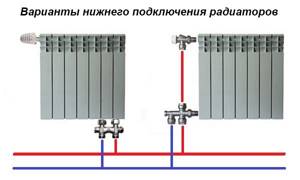
On the right is a headset for the bottom connection of a conventional radiator with side plugs; it also has valves plus the ability to connect a thermal head. Such solutions look very aesthetically pleasing, but will require maximum financial costs. More information about the headset is shown in the video:
Using valves with thermal heads
These are the best taps that can be installed on radiators in the heating system of a private home. Tuned to a certain air temperature, the thermal head acts on the valve stem, forcing it to open or close its flow area. In this way, automatic quantitative regulation of the coolant passing through the heating device occurs.

The thermostatic valve is installed on the supply line to the battery, and a balancing valve is installed on the return line. It is a mistake to assume that the system will be automatically balanced by thermal heads; valves are needed in any case. Installation of conventional ball valves instead of them is allowed for centralized heating or in systems with associated coolant movement (Tichelman loop). But it is unacceptable to regulate the coolant flow using a ball valve, and it will not work.
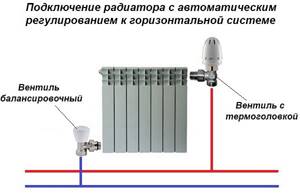
Advice. Most models of thermal valves have a mechanical blocking mode for the flow area. If you received products without such a mode, then to service the battery you will have to install an additional cut-off device, as shown in the diagram:

Adjustment valve for heating radiator, polypropylene, ball, which is better, video and photo
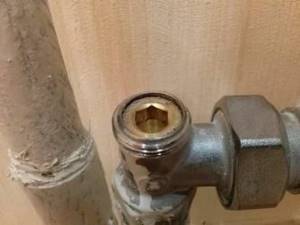
Each heating device is a separate element of the system that requires adjustment and periodic maintenance. If you control the coolant flow through the batteries depending on the heat demand, you can achieve good results in terms of energy savings. That is, radiator valves and heating taps are designed to solve the following problems:
There are many situations in which it is difficult to do without disconnecting the battery. For example, properly working central heating in the middle of spring, when it’s already warm outside, but it’s just hot in the apartment. Another case is the need to remove a heating device for the purpose of replacement, flushing or repair. In the absence of shut-off valves, carrying out any action with the radiator becomes problematic.
Valves are also installed on batteries in retro style
Restriction of the flowing coolant is carried out in order to balance individual heating in a private house or apartment
No matter what type of heating system you have, without balancing with valves, the first radiators will always receive more water than the last ones. Limiting the coolant flow at the beginning of the network and thereby balancing all devices with each other is the task of the control radiator fittings
Automatic control of the flow of incoming coolant is a way to save energy used to heat the house. If each tap on the heating radiator maintains the set air temperature in the room by controlling the flow of water through the radiator, then in general the system will consume only the required amount of heat, no more. And this is a considerable saving.
Well, the problem of air release when filling the system or during operation is also solved by special air valves installed on all modern radiators. Below is a list of types of shut-off and control valves, listed in the same order as the tasks they solve:
For reference. Some home craftsmen use three-way mixing valves to connect heating appliances. But such a solution is unreasonably expensive and is rarely used in practice.
Now we should consider in detail which taps are best installed on radiators in various conditions and circumstances. Some options are clearly shown in the video:
Control taps for heating radiators
Radiator taps are widely used to connect the heating pipeline to the battery. This is a shut-off valve that allows you to control the flow of hot water or turn off a damaged section of the main line. Its also task is to discharge the coolant and prevent the appearance of air jams. Conventional ball-type valves can only be in the “open/closed” position and are not recommended for insertion into the heating system, while special shut-off devices (of a similar design) allow smooth regulation of the coolant circulation process and contribute to more efficient heat transfer.
In essence, such products are shut-off and control valves that are maximally protected from corrosion. The material is brass (sometimes with the addition of lead) or high-quality propylene. In the first case, the radiator tap is attached to a threaded fitting, in the second, welding is used. The metal is coated on top with a protective layer of chromium or nickel (by spraying). The part that regulates the coolant flow is called a thermal head; it is typical exclusively for faucets of this type. Appearance and design look aesthetically pleasing; devices are installed:
Depending on the method of controlling coolant flow, there are:
1. Adjustment taps.
They, in turn, are divided into straight and angular types (mounted depending on the coolant supply). This design allows you to adjust the flow rate exclusively manually, which is not always convenient. The taps are sealed, do not allow leaks, and most importantly, they protect heating radiators from water hammer when filled with water. They do not have a temperature determination scale; the adjustment is carried out with an error. Conventional radiator control valves are best used when assembling an individual heating system. Although their appearance is quite aesthetic, which is why they look good in the office.
2. Devices with a thermostat.
Control of coolant flow in this case is carried out using:
The principle of operation of the taps is based on changing the permeability of the coolant entering the radiator, depending on the temperature in the room. Their insertion helps save energy and allows you to create local zones with the required heat transfer. Faucets with a thermostat are installed in a one- or two-pipe heating system; in the first case, they cannot be installed without bypasses.
3. Thermostatic radiator types.
These are devices for self-control of temperature. The thermal head is a ring with a sensitive element that responds to thermal fluctuations and changes the amount of flow inside the heating circuit. Varieties with manual and automatic adjustment are available. In the first case, the temperature changes independently, in the second - autonomously: when a siphon with liquid exceeds a certain value, it increases its volume and changes the position of the rod. Installation is permissible in both one- and two-pipe heating systems; thermostatic devices are suitable for any connection scheme: side, bottom, diagonal.
Such taps and valves for radiators are economical, despite their high cost. They independently maintain the parameters of the heating system at a given level, protect batteries from freezing and reduce gas consumption, therefore they are especially relevant for private homes. But accurate tracking requires taking into account certain operating conditions, namely: taps with a thermal head are not covered by furniture or other materials, plus they should not be exposed to direct sunlight. If these conditions are not met, then it is worth buying a different type of valve for the heating radiator.
What are radiator taps needed for?
For a general understanding, let’s clarify the terminology a little. In common parlance, faucets are any plumbing device that has a handle for manually controlling the flow of water. In fact, it is technically correct to call a faucet a shut-off valve, but not a control valve. That is, it is intended only to block the flow of liquid, and to regulate its quantity there are other devices - gates and valves. Moreover, all these products are used for batteries.
Shut-off and control valves are placed on the supply pipelines to heating devices for the purpose of:
Item one of the list illustrates well how installing taps on batteries is associated with energy saving. The situation when the central heating system is turned on during the warm period is not uncommon. It’s still quite warm outside, but the radiators are already glowing with heat, and the house is stuffy. If there is a tap, the problem is solved with one turn of the handle. And when a heat energy meter is installed on the entrance or the entire house, then with the same movement you block the flow of funds from the family budget to the account of the heat supply organization.
The same thing happens in a private house equipped with an individual heat source. Taps allow you to turn off part of the radiators in living rooms or temporarily used technical rooms, for example, in a garage
Equally important for saving money is periodic flushing of heating appliances. After all, what happens: a battery contaminated from the inside gives off less heat to the room, which means coolant with a higher temperature goes into the return pipeline
The need for heating
The need to heat your own home has always existed, but the ways to achieve this goal were very different. For hundreds of years, classic Russian stoves were used in Russia, and a little later fireplaces appeared. Traditional heating structures have been replaced by modern devices and heat supply systems, which are superior in quality and efficiency to their predecessors.
Currently, the heating system is a structure that usually consists of the following main elements:
- heating boiler;
- pipeline;
- heating appliances.
There is a coolant inside the heating system. In most cases, water is used to heat private households, since in case of leakage it does not pose a danger to people and the environment from an environmental point of view. Of all types of liquid coolants, it is water that accumulates heat best and, when cooled, releases it.
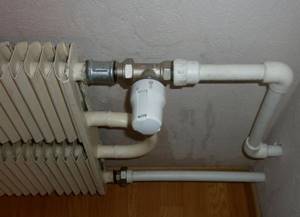
In addition, it flows well and moves almost instantly within the elements of the system. Water is always available in the water pipes and can be added to the heating structure at any time.
The functioning of the system consists of moving hot coolant through it using a circulation pump. The water is first heated in the boiler and then distributed through pipes from which it flows into the radiators.
General recommendations
Experienced craftsmen and professionals recommend taking into account the following points:
- When using a cast iron radiator plug on heating appliances, caution should be exercised. The fact is that cast iron is easily compressible, but is considered a rather fragile material. Therefore, even a slight mechanical impact or impact on a hard surface can cause the formation of microcracks. As for steel products, they are more reliable in this regard.
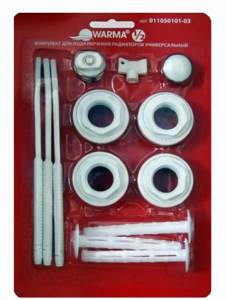
- When studying materials for the assembly and installation of heating devices, there are recommendations for using ordinary paint for more airtight connections. To some extent, these statements are true, but it should be noted that such connections do not have a very attractive appearance, and when disassembling them you may encounter certain difficulties. It is important to understand that modern heating devices and their additional accessories do not require painting.
Selecting and installing radiator plugs is not difficult, but you need to approach this process quite responsibly. It is very important to select matching materials, correctly determine the type of thread and size of the plug, as well as its purpose. By following the recommendations of professional technicians, you can avoid many problems during the operation of the heating system, including batteries and radiators.



